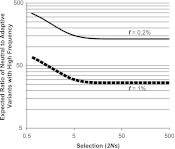Figure 2.
Relative occurrence of neutral and adaptive mutations that will reach high frequency (HF: 50%–90%) in a population, assuming that a fraction f of all new mutations is adaptive. An overwhelming majority of HF mutations in a population are expected to be neutral even when the adaptive mutations have a very high selective advantage (s, increment of fitness) relative to the wild-type allele. The fraction of HF adaptive mutations is not expected to exceed 3.5% even when 1% of all new mutations in a population are adaptive, and the adaptive allele has a very high selective advantage. The expected proportion of HF neutral and adaptive polymorphisms was estimated by using Sawyer and Hartl (1992) equations 11 and 12, which describe the equilibrium flux of mutant alleles reaching high frequency in an effective population size of 2N. Note that increasing the 2Ns will not increase the proportion of adaptive HF polymorphisms, as the elevated probability of entering the high-frequency range is balanced by shortening of the transient polymorphic period. Also, we have used a rather liberal upper bound on the relative proportion of adaptive mutations (f = 1%; dashed line), but the actual fraction is expected to be smaller (f = 0.2%; solid line). For simplicity, only neutral and adaptive mutations were considered in the above calculations, because deleterious mutations are unlikely to rise to very high frequencies (>50%) on their own or by hitchhiking with adaptive variation, because only a small portion of the genome is hitchhiking by adaptive substitutions (Chun and Fay 2011). In any case, the maximum number of deleterious variants with high frequency will be similar to that of beneficial variants. Also, some low-frequency neutral variants will hitchhike to high frequency, which will cause a temporary increase of a high-frequency neutral derived allele during or immediately after the fixation of the adaptive mutation. This will not have any impact on the overall expectations, because such increases are followed by a long period of below-average abundance of high-frequency variants (Kim and Stephan 2000).

